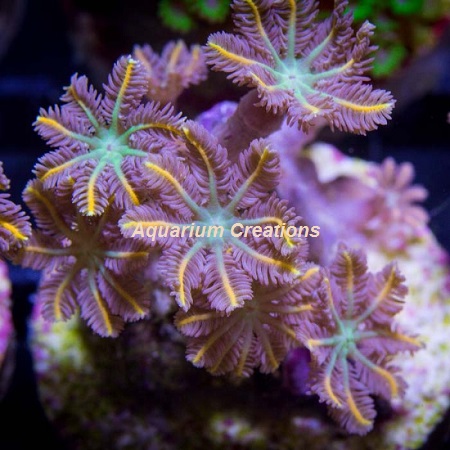Aquacultured Kaleidoscope Clove Polyps are one the nicest of all clove polyps, and one of the hardest to find. Luckily we have been aquaculturing Kaleidoscope Clove Polyps for about 6 years now so we can show and sell the beautiful Kaleidoscope Clove Polyps. What an incredible color combination of both fluorescent orange and fluorescent green. They have long stems and big heads which wave beautifully in the currents. Like all of our polyps they are aquacultured specimens, many generations removed from the original wild starter colonies.
Aggressiveness
They are a peaceful coral with the capability of being able to retract or deflate their polyps in response to a bothersome predator. They will not bother nearby corals since they do not have sweeper tentacles.
Waterflow
We recommend a moderate level of water flow.
Lighting
Kaleidoscope Clove Polyps require a moderate lighting level,(PAR 100-150), to maintain their color. T5's, Metal Halides, or LED's can all grow Daisy Polyps when the proper PAR levels are provided. We recommend a 14-20K color spectrum for best colouration of the coral.
Placement
Kaleidoscope Clove Polyps may be placed anywhere which provides the required water flow and lighting level.
Diet and Feeding
In captivity, the symbiotic algae zooxanthellae hosted within their bodies provide the majority of their nutritional requirements through photosynthesis. We also recommend weekly feeding's of micro-plankton or other reef foods designed for filter feeding invertebrates. Good choices include Marine Snow, Artemia nauplii, and rotifer's. If your lighting is not as strong as desired, the feeding's will be more important since they will not be developing as much zooxanthellae on their own. Increase feeding's to twice a week in that case. For continued good health, we recommend the addition of iodine and other trace elements to the water. To help provide food for all your corals we strongly suggest putting up a refugium for your reef system. Make sure it has at least a 4" sand bed. It really helps your coral do well since it naturally provides correct food for your corals.
|



